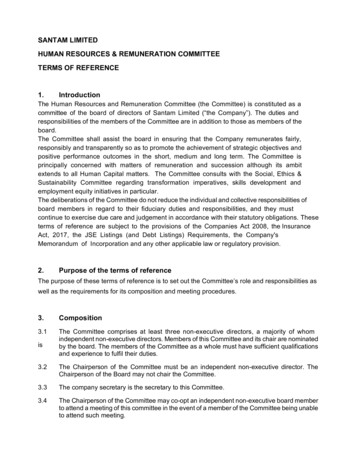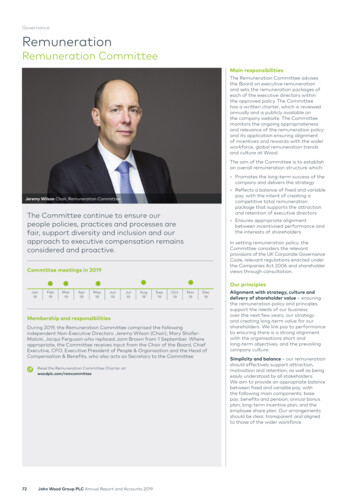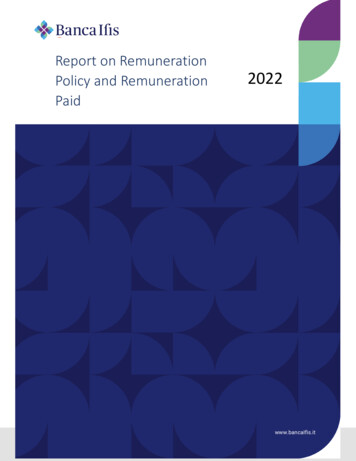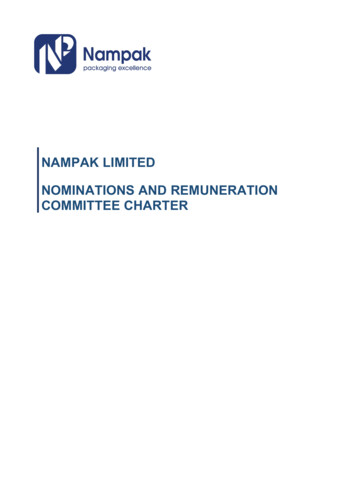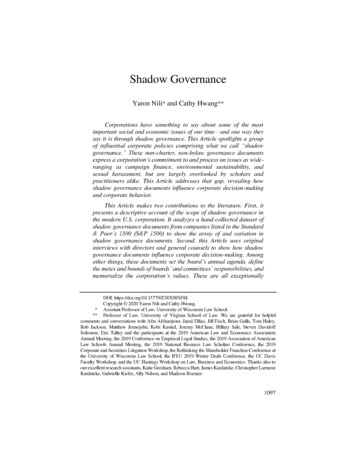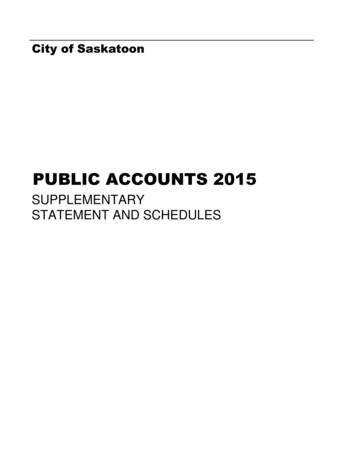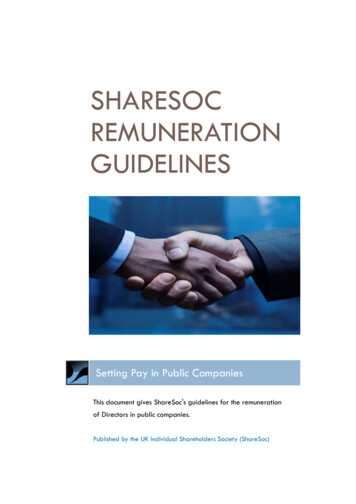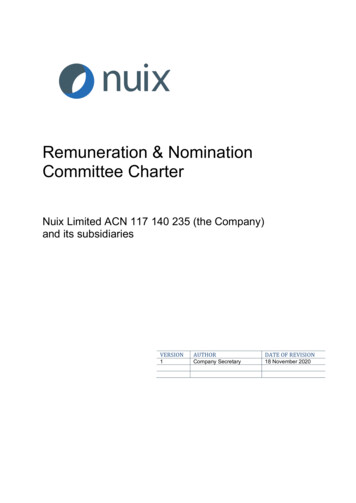
Transcription
Remuneration & NominationCommittee CharterNuix Limited ACN 117 140 235 (the Company)and its subsidiariesVERSION1AUTHORCompany SecretaryDATE OF REVISION18 November 2020
1.INTRODUCTION1.1Purpose of CharterThis is the Charter of the Remuneration & Nomination Committee established by the Board ofthe Company (the Charter). The Charter governs the operations of the Remuneration &Nomination Committee (the Committee). It sets out the Committee's role and responsibilities,composition, structure and membership requirements.1.2Role of CommitteeThe Committee is established by the Board of Directors. The key purpose of the Committee isto ensure the Board is effective and high performing, making sure for example that there is anappropriate number of independent non-executive directors that represent the best interests ofthe Company, that formal and transparent renewal processes are in place and that directorsare being remunerated fairly and responsibly. The Committee will assist the Board byreviewing and making recommendations to the Board in relation to:(a)the Company's remuneration policy, including as it applies to Directors and theprocess by which any pool of Directors' fees approved by shareholders is allocatedto Directors;(b)remuneration packages of senior executives, non-executive Directors and executiveDirectors, equity-based incentive plans and other employee benefit programs;(c)the Company's superannuation arrangements;(d)succession issues and planning for the Board, Chief Executive Officer (CEO),senior executives and executive Directors;(e)the appointment and re-election of people as members of the Board and itscommittees;(f)the Company's recruitment, retention and termination policies;(g)the process for the evaluation of the performance of the Board, its BoardCommittees and individual Directors;(h)the review of the performance of senior executives, which should take place at leastonce every reporting period;(i)the process for recruiting a new Director, including evaluating the balance of skills,knowledge, experience, independence and diversity on the Board and, in the lightof this evaluation, preparing a description of the role and capabilities required for aparticular appointment;(j)the Board's 'skills matrix' and any gaps in the collective skills of the Board; and(k)the size and composition of the Board and strategies to address Board diversity andthe Company's performance in respect of the Company's Diversity Policy, includingwhether there is any gender or other inappropriate bias in remuneration forDirectors, senior executives or other employees.1
2.MEMBERSHIP2.1Composition of CommitteeThe Committee will:2.2(a)comprise only of members of the Board of Directors (Directors) and members willbe appointed and removed by the Board;(b)be of sufficient size, independence and technical expertise to discharge its mandateeffectively;(c)consist of:(i)at least three members;(ii)only non-executive directors;(iii)a majority of independent 1 Directors (Independent Directors);(iv)an independent chairperson, who will be nominated by the Board fromtime to time, but who will either be the Chair of the Board or anIndependent Director;(v)if the Committee Chair is also the chair to the Board, then a separateCommittee Chair will be appointed to chair any discussions by theCommittee involving succession planning for the role of chair to theBoard;(d)include at least one member who has expertise in remuneration; and(e)comprise members who will be appointed for a fixed period of no more than3 years, with Committee members generally being eligible for re-appointment for solong as they remain Independent Directors.Ceasing to be a member of the CommitteeA person will cease to be a member of the Committee if:2.3(a)the person gives reasonable notice in writing to the Committee Chair of the person'sresignation as a member of the Committee;(b)the Committee Chair gives the person notice in writing that the person is to cease tobe a member of the Committee; or(c)the person ceases to be a Director, in which case the person automatically ceasesto be a member of the Committee.Secretary(a)The Committee will have a secretary, which is to be the Company Secretary or suchother person as nominated by the Board (Committee Secretary).Refer to the meaning of independent as discussed in the Corporate Governance Principles and Recommendations(4th edition) of the ASX Corporate Governance Council, as outlined in Schedule 1.12
(b)The Committee Secretary will attend all Committee meetings.(c)The Committee Secretary, in conjunction with the Chair of the Committee, mustprepare an agenda to be circulated to each Committee member at least 2 fullworking days prior to each meeting of the Committee.(d)The Committee Secretary will distribute a meeting timetable for each forthcomingcalendar year.3.MEETINGS & AUTHORITY OF COMMITTEE3.1Meetings3.2(a)The Committee will meet as often as necessary, but must meet at least twice a yearand one of those meetings must take place at least 2 months prior to each annualgeneral meeting.(b)The Chair of the Committee must call a meeting of the Committee if so requestedby any Committee member, the Managing Director or the Company Secretary.(c)The Committee may invite other persons, including internal specialists or externaladvisers, to attend meetings if considered appropriate by the Chair of theCommittee.(d)The quorum necessary for a meeting of the Committee will be 2 members, of whomat least one must be an Independent Director.AuthorityThe Board authorises the Committee, within the scope of its responsibilities, to:(a)investigate any matter within the ambit of the role of the Committee as described inparagraph 1.2, which is brought to its attention with full access to all books, recordsand facilities;(b)seek any information it requires from an employee (and all employees are directedto co-operate with any request made by the Committee) or external parties;(c)obtain outside professional advice as it determines necessary to carry out its duties;and(d)ensure the attendance of Company officers at meetings as it thinks appropriate.4.DUTIES AND RESPONSIBILITIES4.1Understanding the Company's BusinessThe Committee will ensure it understands the Company's structure, business and controls toensure that it can adequately assess the significant risks faced by the Company.4.2Reporting(a)The Chair of the Committee must report the findings and recommendations of theCommittee to the next Board meeting following each meeting of the Committee.(b)The minutes of all Committee meetings will be circulated to members of the Boardby the Committee Secretary.(c)The Chair of the Committee must submit an annual report to the Boardsummarising the Committee's activities during the reporting period, including the3
number of times that the Committee met throughout that period and the individualattendances of Committee members at those meetings, and the Committee'ssignificant results and findings.(d)4.3The Committee must approve:(i)the details to be published in the Company's Annual Report or any otherstatutory report or document with respect to the activities andresponsibilities of the Committee; and(ii)any statement on the Company's remuneration policy and executivecompensation disclosures that may be required by law or otherregulatory requirements (including any such statement to be included inthe Company's Annual Report).Specific responsibilitiesIn addition to any other matters which may be delegated to the Committee by the Board(including special investigations), the Committee is responsible for:Remuneration of senior executives and executive Directors(a)regularly reviewing and making recommendations to the Board with respect to anappropriate remuneration policy of senior executives and executive Directors,including (as appropriate) fixed, performance-based and equity-basedremuneration, reflecting short and long term performance objectives appropriate tothe Company's circumstances, goals and commercial interest in controllingexpenses, as well as retirement benefits and termination payments, , ensuring thatsuch a policy:(i)enables the Company to attract and retain valued employees;(ii)motivates senior executives and executive Directors to pursue the longterm growth and success of the Company without rewarding conductcontrary to the Company's values or risk appetite;(iii)demonstrates a clear relationship between performance andremuneration and remuneration being a key driver of culture and keyfocus for investors; and(iv)has regard to prevailing market conditions to ensure that directors areremunerated reasonably, and not excessively.Remuneration of non-executive Directors(b)making recommendations as to the structure of remuneration for non-executiveDirectors(c)ensuring that fees paid to non-executive Directors are within the aggregate amountapproved by shareholders and making recommendations to the Board with respectto the need for increases to this aggregate amount at the Company's annualgeneral meeting;(d)has regard to the need to ensure that the incentives for non-executive directors donot conflict with their obligation to bring an independent judgement to mattersbefore the Board;4
Employee benefits and other policies(e)review and oversee the implementation, administration and operation ofequity-based incentive plans and other employee benefit programs;(f)regularly reviewing the Company's recruitment, retention and termination policies;Superannuation(g)regularly reviewing and providing advice to the Board in relation to the Company'ssuperannuation arrangements;Senior executives and executive Directors succession(h)reviewing succession plans of senior executives and executive Directors on aregular basis to maintain an appropriate balance of skills, experience and expertisein the management of the Company and providing advice to the Board accordingly;Board succession(i)reviewing Board succession plans on a regular basis to maintain an appropriatebalance of skills, knowledge, experience, independence, diversity and expertise onthe Board and providing advice to the Board accordingly;New Directors(j)developing policy, and procedures and processes for the selection and appointmentof Directors;(k)identifying individuals who may be qualified to become Directors, having regard tosuch factors as the Committee considers appropriate, including judgement, skill,diversity, experience with business and other organisations of a comparable size,the interplay of the candidate's experience with the experience of other Boardmembers, the extent to which the candidate would be a desirable addition to theBoard and any Board Committee, and the Corporate Governance Principles andRecommendations (4th edition) of the ASX Corporate Governance Council (theGuidelines);(l)ensuring that an effective orientation program for new Directors is in place, andregularly reviewing its effectiveness;Board Committees(m)identifying Directors qualified to fill vacancies on Board committees and makingrecommendations to the Board accordingly, having regard to such factors as theCommittee considers appropriate, including the terms of reference of the particularBoard committee the Director's experience, the interplay of the Director'sexperience with the experience of other Committee members and the Guidelines;Performance(n)developing or arranging a program for inducting new Directors and periodicallyidentifying any gaps in the collective skills of the Board that should be addressedand reviewing the need for existing Directors to undertake professional5
development to maintain the skills and knowledge needed to perform their role asdirectors effectively. 2(o)in conjunction or collaboration with the Board, developing and implementingprocedures for the annual evaluation of the performance of the Board, each BoardCommittee and individual Directors, comparing their performance with therequirements of the Board Charter, this Charter, other relevant Board CommitteeCharters and the reasonable expectations of individual Directors;(p)ensuring that the performance of each senior executive and executive Director isevaluated at least once every reporting period;Shareholder approval(q)considering those aspects of the Company's remuneration policies and packages,including equity-based incentives, which should be subject to shareholder approvaland making recommendations to the Board accordingly;Size and composition of the Board(r)considering and articulating the time needed to fulfil the role of Chair andnon-executive Director;(s)regularly reviewing the size and composition of the Board and makingrecommendations to the Board with regard to any appropriate changes;(t)providing advice to the Board with respect to the necessary and desirablecompetencies of Directors;(u)making recommendations to the Board for the appointment and removal ofDirectors;(v)in a timely manner, making recommendations to the Board whether or not Directors,whose term of office is expiring, should be proposed for re-election at theCompany's next AGM;Diversity(w)developing measurable objectives to achieve gender diversity in the composition ofthe Board, senior executives and workforce generally in accordance with theCompany's Diversity Policy;(x)monitoring, reviewing and reporting to the Board on the Company's performance inrespect of gender diversity in accordance with the Company's Diversity Policy;(y)reviewing the Company's Diversity Policy at least annually to assess theeffectiveness of the policy and make recommendations to the Board as to anystrategies required to address Board diversity;(z)reviewing and reporting to the Board at least annually on the relative proportion ofwomen and men at all levels of the business; and(aa)reviewing and making recommendations to the Board on remuneration by gender.Principle 2.6 of the Corporate Governance Principles and Recommendations (4th edition) of the ASX CorporateGovernance Council provides guidance as to what the induction programs should cover.26
The Committee will have no executive powers with regard to its findings andrecommendations.4.44.5Other matters(a)The Committee is authorised to engage, at the Company's expense, outside legalor other professional advice or assistance on any matters within its terms ofreference.(b)The Committee is authorised to seek any information it requires from any officer oremployee of the Company and such officers or employees will be instructed by theBoard of the Company employing them to respond to such enquiries.(c)The Committee may, in its discretion, delegate all or some of its responsibilities to asub-committee.Committee performance assessment(a)The Committee will perform an evaluation of its performance at least annually todetermine whether it is functioning effectively by reference to current best practice.(b)The Board will evaluate the performance of the Committee at least annually.5.OTHER MATTERS5.1Amendment of CharterThis Charter can only be amended with the approval of the Board.5.2Adoption of Charter and periodic reviewThis Charter was adopted by the Board on the date on the front page of this Charter, andtakes effect from that date and replaces any previous Charter in this regard.The Committee must review and reassess this Charter at least annually and, if required, makerecommendations to the Board in respect of any amendments to the Charter. The Board willalso review this Charter periodically. The Company Secretary will communicate anyamendments to employees as appropriate.7
Schedule 1 - Independence as defined by the ASX Corporate Governance Councilin their Corporate Governance Principles and Recommendations (4th edition)A director of a listed entity should only be characterised and described as an independent director if he orshe is free of any interest, position or relationship that might influence, or reasonably be perceived toinfluence, in a material respect their capacity to bring an independent judgement to bear on issues beforethe board and to act in the best interests of the entity as a whole rather than in the interests of anindividual security holder or other party.The ASX Corporate Governance Principles and Recommendations (4th edition) provide certain examplesfor assessing the independence of directors and outline relationships which may affect independentstatus. They provide that when determining the independent status of a director the board shouldconsider whether the director:1.is, or has been, employed in an executive capacity by the entity or any of its child entities andthere has not been a period of at least three years between ceasing such employment andserving on the board;2.receives performance-based remuneration (including options or performance rights) from, orparticipates in an employee incentive scheme of, the entity;3.is, or has been within the last three years, in a material business relationship (eg as a supplier,professional adviser, consultant or customer) with the entity or any of its child entities, or is anofficer of, or otherwise associated with, someone with such a relationship;4.is, represents, or is or has been within the last three years an officer or employee of, orprofessional adviser to, a substantial holder;5.has close personal ties with any person who falls within any of the categories described above;or6.has been a director of the entity for such a period that their independence from managementand substantial holders may have been compromised.Where a director falls within one or more of these examples, the board should rule the director not to beindependent unless it is clear that the interest, position or relationship in question is not material and willnot interfere with the director’s capacity to bring an independent judgement to bear on issues before theboard and to act in the best interests of the entity as a whole rather than in the interests of an individualsecurity holder or other party.8
The Charter governs the operations of the Remuneration & Nomination Committee (the Committee ). It sets out the Committee's role and responsibilities, composition, structure and membership requirements. 1.2 Role of Committee The Committee is established by the Board of Directors. The key purpose of the Committee is to ensure the Board is effective and high performing, making sure for example .

